
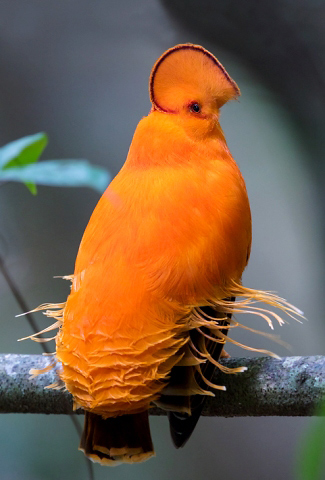
A fabulous male Guianan Cock-of-the-rock at Surama in Guyana by Dubi Shapiro.
- Lots of Guiana Shield Endemics such as Sun Parakeet, Capuchinbird, Guianan Cock-of-the-rock and Dusky Purpletuft
- Some of South America’s and the world’s other most spectacular localized birds including Guianan Red-cotinga, Crimson Fruitcrow, Pompadour and Purple-breasted Cotingas, and Red Siskin
- And some of South America’s and the world’s most spectacular other birds including Scarlet Ibis, Sunbittern, Hoatzin, Blue-and-yellow, Red-and-green and Scarlet Macaws, Crimson Topaz, jacamars, toucans and White-plumed Antbird
- As well as a chance of Giant Anteater, Giant Otter and several species of monkey including Red Howler
- And Kaieteur Falls, one of the most
spectacular waterfalls in the world - All in a sparsely populated country (less than a million people in an area the size of Britain) with over 70-80% of its rainforest still intact
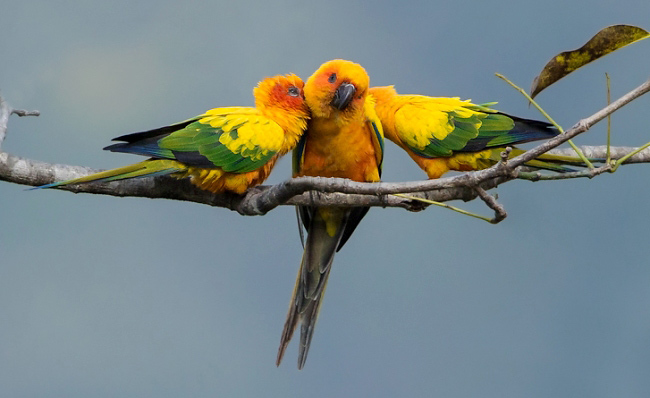
Sun Parakeets at Karasabai by Dubi Shapiro.
Best Birds and other wildlife in Guyana
Birds
Near-endemics
Guyana and Venezuela 2 Fiery-shouldered Parakeet and Red-banded Fruiteater.
Guyana, Venezuela and Colombia 2 Northern Festive Parrot and Red Siskin.
Guianas, Venezuela and Colombia 1 Lilac-tailed Parrotlet.
Guyana, Venezuela and Suriname 2 Blue-cheeked Amazon and Guianan (Rufous-brown) Solitaire.
Guyana, Venezuela and Brazil 35 Roraiman Nightjar, Tepui Swift, Tepui Goldenthroat, Peacock Coquette, Velvet-browed Brilliant, Rufous-breasted Sabrewing, Copper-tailed (Green-bellied) Hummingbird, Tepui Parrotlet, Roraiman Antwren, Streak-backed Antshrike, Roraiman Antbird, Tepui Antpitta, White-throated Foliage-gleaner, Roraiman Barbtail, Tepui Spinetail, Olive Manakin, Scarlet-horned Manakin, Orange-bellied Manakin, Rose-collared Piha, Green-cheeked (Green-backed) Becard, Black-fronted Tyrannulet, Chapman’s Bristle-tyrant, Sierra de Lema (McConnell’s) Flycatcher, Ruddy Tody-flycatcher, Tepui Elaenia, Flutist Wren, Tepui Wren, Pantepui (Black-billed) Thrush, Tepui Brush-finch, Golden-tufted Grackle, Roraiman (Two-banded) Warbler, Tepui Whitestart, Olive-backed Tanager, Greater Flowerpiercer and Black-hooded Tanager.
Guianas, Venezuela and Brazil 36 Guianan Puffbird, Tepui Toucanet, Guianan Toucanet, Green Aracari, Black-spotted Barbet, Caica Parrot, Painted Parakeet, Northern Red-shouldered Macaw, Brown-bellied Stipplethroat (Antwren), Spot-tailed Antwren, Todd’s Antwren, Black-throated Antshrike, Guianan Antwarbler (Warbling Antbird), Ferruginous-backed Antbird, Red-billed Woodcreeper, Chestnut-rumped Woodcreeper, Lineated (Guianan) Woodcreeper, McConnell’s Spinetail, Tiny Tyrant-manakin, Crimson-hooded Manakin, White-throated Manakin, Guianan Red-cotinga, White Bellbird, Dusky Purpletuft, Glossy-backed Becard, Olivaceous Schiffornis (Mourner), Smoky-fronted Tody-flycatcher, Painted Tody-flycatcher, Guianan Tyrannulet, Olive-crowned Greenlet, Tepui Vireo (not French Guiana), Cayenne Jay, Finsch’s Euphonia, Golden-sided Euphonia, Red-and-black Grosbeak and Blue-backed Tanager.
Guyana and Brazil 4 Sun Parakeet, Rio Branco Antbird, Willis’s Antbird and Hoary-throated Spinetail.
Guyana, Brazil and Bolivia 1 Pale-bellied Tyrant-manakin.
Guianas 1 Blood-coloured Woodpecker.
Guianas and Brazil 6 Northern Long-tailed Woodcreeper, Olive-green Tyrannulet, Boat-billed Tody-tyrant, Todd’s Sirystes, White-throated Pewee (not Guyana) and Guianan Gnatcatcher.
Other Specialities
Grey-winged Trumpeter, Harpy Eagle, Rufous Crab-hawk, Green-throated Mango, White-winged Potoo, Toco Toucan, White-bellied Piculet, Red-fan Parrot, Spotted
and Thrush-like Antpittas, Black Manakin and Bearded Tachuri. Also a chance of Zigzag Heron, Rufous-winged Ground-cuckoo, Nacunda Nighthawk and
Orange-breasted Falcon.
Others
Blue-and-yellow, Red-and-green and Scarlet Macaws, Scarlet Ibis, Sunbittern, Channel-billed and White-throated Toucans, Hoatzin, Crimson Topaz,
Black-eared Fairy, White-plumed Antbird, Bronzy, Great, Green-tailed, Paradise and Rufous-tailed Jacamars, Magnificent Frigatebird, (American)
Swallow-tailed Kite, and Pompadour, Purple-breasted and Spangled Cotingas, as well as Muscovy Duck, Little Chachalaca, Spix’s Guan, Brown Pelican, Anhinga,
Rufescent Tiger-heron, Boat-billed and Capped Herons, Pinnated Bittern, Buff-necked and Green Ibises, Jabiru, Maguari Stork, King Vulture, Pearl and Snail
Kites, hawks including Black-collared, Savannah and White, Ornate Hawk Eagle, Red-throated Caracara, Aplomado and Laughing Falcons, Grey-necked Wood-rail,
Sungrebe, Limpkin, Double-striped Thick-knee, Pied Plover, Wattled Jacana, Large-billed and Yellow-billed Terns, Black Skimmer, pigeons, doves, Red-bellied
and Red-shouldered Macaws, parakeets such as Painted, parrots, Squirrel Cuckoo, nighthawks, nightjars, White-chinned, White-collared and White-tipped
Swifts, Rufous-throated Sapphire, White-tailed Goldenthroat, trogons, all five South American kingfishers, puffbirds including Spotted, Swallow-wing,
Black-spotted Barbet, Black-necked Aracari, woodpeckers including Waved, Yellow-chinned Spinetail, woodcreepers, antshrikes, antwrens, antbirds including
Ferruginous-backed and White-browed, Rufous-capped Antthrush, tyrannulets, Short-tailed Pygmy-tyrant (the smallest passerine in the world along with
Black-capped Pygmy-tyrant), tody-tyrants, tody-flycatchers including Spotted, flycatchers such as Fork-tailed and Vermilion, Screaming Piha, Bare-necked
and Purple-throated Fruitcrows, Golden-headed Manakin, tityras, wrens, Long-billed Gnatwren, Black-capped Donacobius, Black-faced and Blue Dacnises,
Spotted and Turquoise Tanagers, honeycreepers, Red-capped Cardinal, Crested and Green Oropendolas, Yellow-rumped Cacique, Orange-backed Troupial,
Yellow-hooded Blackbird and euphonias.
Mammals
Red Howler, Black Spider, (South American) Squirrel, Brown-bearded Saki, Guianan (White-faced) Saki, Brown
Capuchin and Weeping Capuchin Monkeys, Red-rumped Agouti, Collared Peccary, and Greater Bulldog (Fishing) and Lesser Fishing Bats. Also a good chance
of Giant Anteater and Giant Otter, a chance of (Pale-throated) Three-toed Sloth, Golden-handed Tamarin, Capybara, Kinkajou and Tayra, and an outside
chance of Jaguar and Brazilian Tapir.
Reptiles, Amphibians and Fish
Black and Spectacled Caimans, Golden (Poison-dart) Frog and Arapaima (one of the largest
freshwater fishes in the world, reaching a length in excess of 2 m (6.5 ft)).
Plants
The rich plant life includes the Giant Water Lily and the largest Tank Bromeliads in the world (which support
Golden Frogs, at Kaieteur Falls).
Other Natural Wonders in Guyana
Kaieteur Falls
One of the world’s most spectacular waterfalls is about five times as high as Niagara Falls and twice as
high as Victoria Falls. It has one of the most voluminous single drops in the world, a 100 m (330 ft) wide and about 226 m (742 ft) high deluge of
water best seen during the wet seasons which usually last from May to July and November to January. The total height of the falls is 251 m (824 ft).
Best Sites for Birds and other wildlife in Guyana
- Georgetown Botanical Gardens/Bird Sanctuary Festive Parrot.
- Coast east to Abary River and Mahaica River Areas Scarlet Ibis, Hoatzin (Mahaica), Magnificent Frigatebird, Rufous Crab-hawk (Abary), Green-throated Mango and Blood-coloured Woodpecker (Abary).
- Arrowpoint NR Sunbittern, Crimson Topaz (lek), Black-eared Fairy and White-plumed Antbird.
- Kaieteur Falls Guianan Cock-of-the-rock (lek), Golden Frog and swifts. Also a chance of Orange-breasted Falcon.
- Iwokrama Reserve A 30 m (100 ft) high and 150 m (500 ft) long canopy walkway with four observation platforms (at ATTA), and over 500 bird species recorded including Blue-and-yellow, Red-and-green and Scarlet Macaws, Channel-billed and Red-billed Toucans, Crimson Topaz, Black-eared Fairy, Bronzy, Great and Paradise Jacamars, White-plumed Antbird, Capuchinbird (lek near Iwokrama River Lodge), Pompadour, Purple-breasted and Spangled Cotingas, Black Curassow, Guianan Puffbird, Guianan Toucanet, Black-throated Antshrike, Spotted and Thrush-like Antpittas, Red-and-black Grosbeak and Golden-sided Euphonia. Also a chance of Grey-winged Trumpeter, Zigzag Heron, Orange-breasted Falcon (from Turtle Mountain Viewpoint), Sunbittern, Rufous-winged Ground-cuckoo, five species of potoo, Red-billed Woodcreeper, Sharpbill, Guianan Red-cotinga, White Bellbird, Crimson Fruitcrow, Dusky Purpletuft, Rose-breasted Chat, Blue-backed and Paradise Tanagers, and (Pale-throated) Three-toed Sloth.
- Surama Red-and-green Macaw, Guianan Cock-of-the-rock (lek), Black-eared Fairy, Green-tailed and Paradise Jacamars, Pompadour, Purple-breasted and Spangled Cotingas, and Black Curassow. Also a chance of Giant Otter, Harpy Eagle, Red-and-green and Scarlet Macaws, Grey-winged Trumpeter, Zigzag Heron, Rufous-winged Ground-cuckoo and Crimson Fruitcrow.
- Rockview Lodge, Annai Guianan Cock-of-the-rock (lek, at Corkwood), Great and Yellow-billed Jacamars, and Jabiru. Also a chance of Toco Toucan and Nacunda Nighthawk.
- Rupununi Savanna Sunbittern, Capuchinbird (leks at Karanambu Ranch), Bearded Tachuri, Crested Doradito, Crestless Curassow, Boat-billed and Capped Herons, Jabiru, Grey-necked Wood-rail, Green-and-rufous Kingfisher, Spotted Puffbird, Great Slaty Antshrike, Bare-necked Fruitcrow, Blue-backed Manakin, Orange-backed Troupial, Arapaima and Giant Water Lily. Also a good chance of Giant Anteater, Giant Otter and Capybara, and a chance of Agami Heron, Lesser Razor-billed Curassow, Sungrebe, Nacunda Nighthawk and Rose-breasted Chat.
- Lethem-Karasabi Area Sun Parakeet (Karasabi, north of Lethem), Hoary-throated Spinetail (Takatu-Ireng Rivers junction), Rio Branco Antbird (Takatu-Ireng Rivers junction) and Red Siskin. Also a chance of Red-and-green Macaw, Bronzy Jacamar, Toco Toucan and Guianan Gnatcatcher.
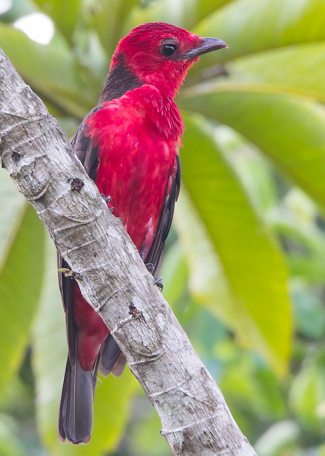
A rare image of a Crimson Fruitcrow captured at Iwokrama by Dubi Shapiro.
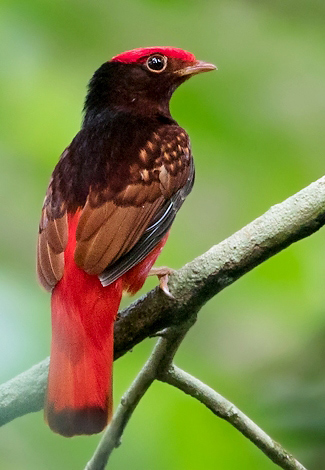
Another rare image, of a Guianan Red-cotinga, at ATTA, by Dubi Shapiro.
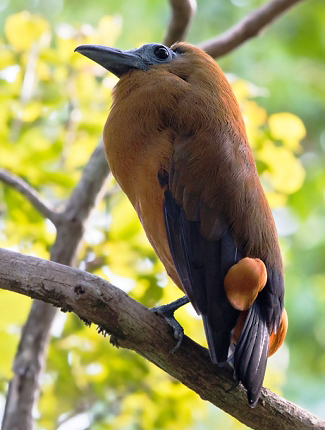
And yet another superb image by Dubi Shapiro, this time of a displaying Capuchinbird at Karanambu.
Best Times for Birds and other wildlife in Guyana
The best times to look for the wildlife are the driest times of the year which usually last from February to April and August to October but Kaieteur Falls is usually most impressive during the wet seasons which usually last from May to July and November to January.
Recommended Bird Books etc. for Guyana
Guyana by K Smock. Bradt Travel Guides, 2011 (Second Edition).
Birds of Venezuela by D Ascanio, G Rodriguez and R Restall. Helm, due 2017.
Field Guide to the Birds of Venezuela by S Hilty. Helm, 2002.
Birds of South America: Non-Passerines by J R Roderiguez Mata et al. Harper Collins, 2006.
Birds of South America: Passerines by R S Ridgely and G Tudor. University of Texas Press/Helm, 2009 (Updated paperback edition of books listed next with 400 more illustrations).
The Birds of South America: Passerines by R S Ridgely and G Tudor. University of Texas Press, 1989 and 1994 (Two volumes).
Birds of Northern South America by R Restall, C Rodner and M Lentino. Helm, 2006 (Two volumes).
Mammals of South America by R D Lord. Johns Hopkins University Press, 2007.
Apps etc.
All Birds Guianas by Bloomsbury/Sunbird Images.
Where to watch birds in South America by N Wheatley. Helm, 1994.
Don’t know which country/countries to visit in South America? Then it may be worth considering taking a look at this book, written by this website’s author. It is many years old of course but it still provides a starting point, an overview and a guiding light to the best birds and the best places to look for them on the continent, and could save hours of searching for similar information on the internet. However, it is important to check more up-to-date sources for sites which have been opened up, sites and species which have been discovered, lodges that have been built etc. since the book was published.
Birding and Wildlife Trip Reports for Guyana
Many trip reports, some for Guyana, are posted on the websites listed here. On some of these websites some reports are independent and some are posted by tour companies who organize tours to Guyana. These tour companies and others also post their own reports on their websites, which are listed under 'Some Organized Tours to Guyana' below.
- The best website for trip reports is CloudBirders
- but these are also worth a look
- Birdtours
- Fatbirder
- Jon Hornbuckle
- Mammal Watching
Local bird and wildlife guides in Guyana
The costs of organized tours partly reflect the quality of the tour leaders. Some leaders are certainly better than others and many companies claim their leaders are the best but even the best rely at least to some extent on the exceptional skills of the local guides they employ. If you are travelling independently, employing such local guides will greatly increase your chances of seeing the wildlife you wish to see.
Accommodation for birders in Guyana
Some Organized Tours for birds and other wildlife to Guyana
There are many tour companies who organize tours to see mammals, birds, other wildlife and other natural wonders. The cost of these tours vary considerably according to such variables as the airlines used, the number of days the tours last, the number of sites visited, the number of people in the group (an important consideration if you wish to see such wildlife as rainforest mammals and birds), the number of tour leaders, the standard of accommodation and transport, and the percentage profit the company hopes to make. Generally, where the number of days tours last and the number of sites visited are similar, the cheapest tours are those that use the cheapest airlines, accommodation and local transport, that have the largest groups with the least number of leaders, and that make the least amount of profit. The most expensive tours tend to be those which are exceptionally long, use the most expensive accommodation (ridiculously lavish in some cases, even for single nights) and which make the most profit. Some tour costs partly reflect the quality of the tour leaders. Some leaders are certainly better than others and many companies claim their leaders are the best but even the best rely at least to some extent on the exceptional skills of the local guides they employ.
While tour companies organize tours with set itineraries many also organize custom tours for individuals and private groups who instead of taking a tour with a set itinerary want to follow their own itinerary to suit their own personal tastes, whether it be mammals, birds, other wildlife, other natural wonders or even man-made attractions, or a mixture of them all. Many organized tours with set itineraries are also fast-paced and target as many species as possible, whether they are mammals, birds or other wildlife or everything, which usually leaves little time to enjoy the best sites and individual species, but on a custom tour those taking part can specify the pace and the sites and species they wish to concentrate on. Custom tours also suit people who like to travel with people they already know, rather than with a group of strangers, and people with partners with different interests. Individuals and small groups will almost certainly have to pay more than the price of an organized tour with a set itinerary but a large group of friends may be able to travel for less than the price quoted for a set tour.
Tour companies who are running organized tours to Guyana in the next couple of years include the following. Many of these also offer custom tours.
